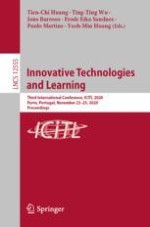2020 | OriginalPaper | Chapter
Development of Constructivist Web-Based Learning Environment Model to Enhance Problem-Solving and Transfer of Learning on Student in Industrial: Integration Between Pedagogy and Neuroscience
Authors : Chan Singkaew, Sumalee Chaijaroen
Published in: Innovative Technologies and Learning
Publisher: Springer International Publishing
Activate our intelligent search to find suitable subject content or patents.
Select sections of text to find matching patents with Artificial Intelligence. powered by
Select sections of text to find additional relevant content using AI-assisted search. powered by
